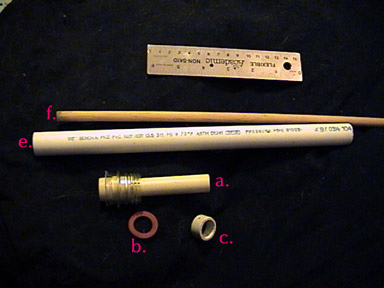
The parts to make and use an SST-Nozzle
- a. 1/2 inch CPVC connector fitting, with a short piece of CPVC glued on the end.
- b. Garden hose washer
- c. short piece of 1/2 inch PVC thick-wall pipe, slightly filed out inside so it slides over the short CPVC pipe.
- d. don't know where d. is, i think my cats got it.
- e. length of thin-wall PVC pipe for a pusher
- f. Length of wooden dowel for a centering guide.
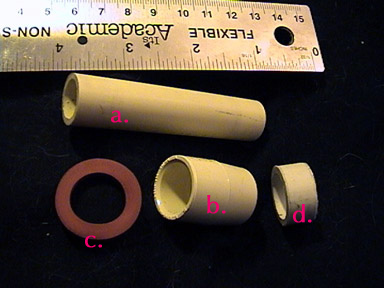
The SST-Nozzle Parts
- a. short piece of 1/2 inch CPVC pipe
- b. 1/2 inch CPVC coupling
- c. Garden hose washer (interior hole slides nicely over the pipe)
- d. Centering ring - made from a short piece of thick-wall PVC. You will have to file out the inside diameter so that it will slide over the CPVC pipe.
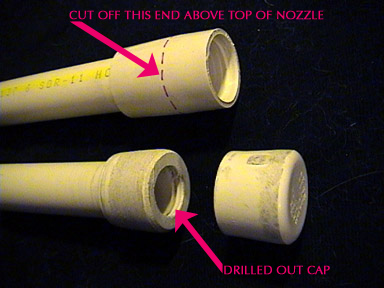
SST-Nozzle head
I used an unaltered coupling in these photos. If you like, you can cut off the un-need top of the coupling, ABOVE the widest point. (top)
or, you can use a 1/2 inch end cap, then cut of the end or drill through the end. You will probably have to lightly sand the widest part of the end so that it will just slip through the throat of a PET bottle. (bottom)
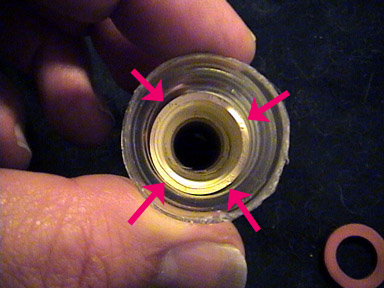
SST-Nozzle in the throat
This photo shows how the head of the SST-Nozzle just slides through the throat of a PET bottle neck.
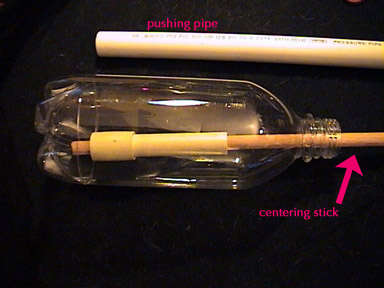
Put the SST-Nozzle inside the rocket body
Put your centering dowel into the rocket body, and slide the SST-Nozzle head first down inside the rocket. Keep it on the centering dowel.
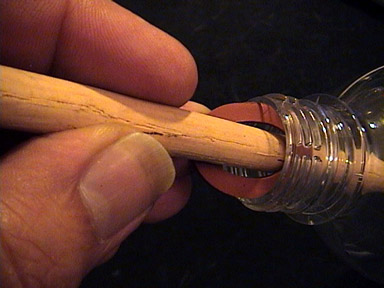
Insert the Garden Hose Washer into the rocket
Slide the washer down over the centering dowel, pinch it so it fits down into the neck of the rocket and let it fall inside down the centering dowel.
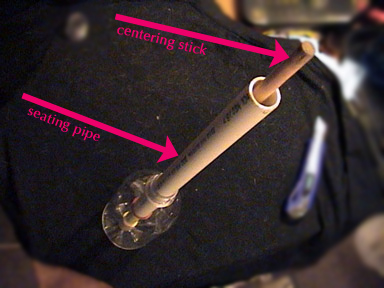
Getting the washer onto the SST-Nozzle
Use a length of PVC thin-wall pipe as a seating pipe. Slide it over the centering dowel and nudge the washer onto the end of the nozzle.
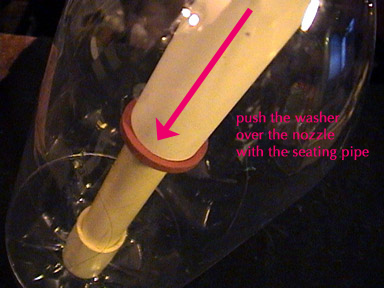
Seat the washer
Push the washer all the way down the nozzle until it contacts the shoulder of the CPVC coupling head.
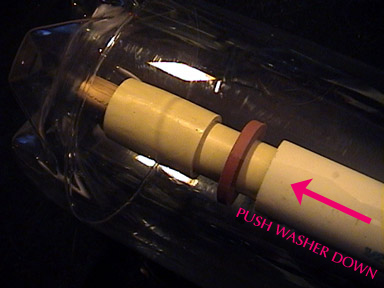
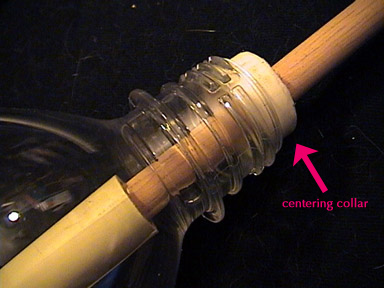
Inserting centering collar
To center the SST-Nozzle in the throat of the rocket neck, slide your centering collar down the centering dowel into the neck of the bottle. The centering collar should fit snuggly- but not too tight- on the pipe of the nozzle.
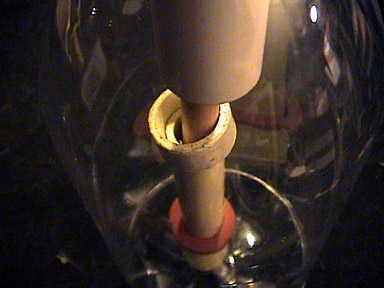
Centering collar inside the rocket
Turn the rocket body nozzle up, slide your pushing pipe down the dowel and work the centering collar over the SST-Nozzle pipe and snug it down on the washer.
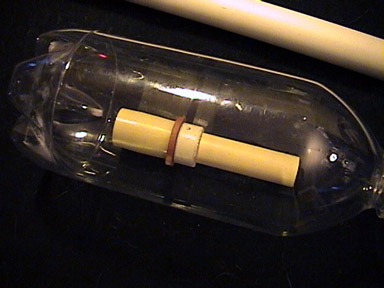
The complete SST-Nozzle inside the rocket body
The SST-Nozzle is now assembled inside your rocket, and ready to go!
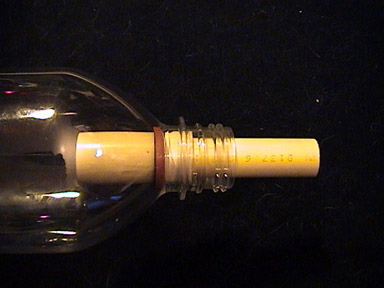
SST-Nozzle in place for action
This is how the SST-Nozzlee will look when it enters the throat of the open PET nozzle
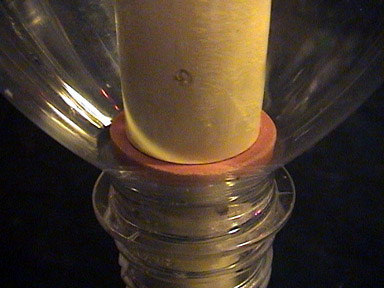
The SST-Nozzle seal
Since the CPVC coupling just barely fits through the neck of the bottle, the extra diameter of the washer makes the assembly to big to get shoved out the neck of the bottle. Internal pressure keeps the SST-Nozzle against the opening of the bottle. The water and air have no where to go but thru the CPVC pipe. (see last picture about alternatives to garden washer seal)
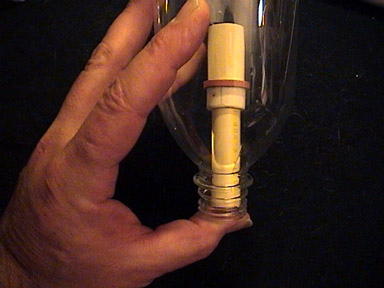
Loading the Rocket and SST-Nozzle on the launch tube
Pour your selected amount of water into the rocket body. Put your thumb over the end, turn the rocket over. The SST-Nozzle will fall to the bottom. You can quickly move your thumb and push your rocket down over and onto the launch tube of your launcher. You will lose a little water, so you might want to use a little extra water in your fill. (water not used in the photo)
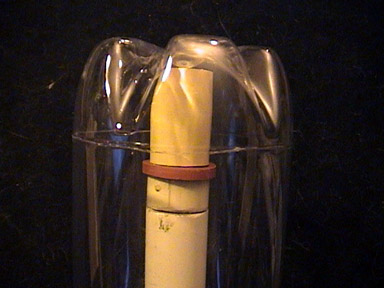
The SST-Nozzle ready for launching
You must have a launch tube that is slighly shorter than normal to compensate for the extra length of the SST-Nozzle. When the trigger is pulled, the pressure sends your rocket up the lauch tube. The SST-Nozzle drops into the throat of the PET bottle, the centering colar under the washer centers the SST-Nozzle in the neck of the bottle. Your rocket rises on the reduced size column of water. Woo hoo!
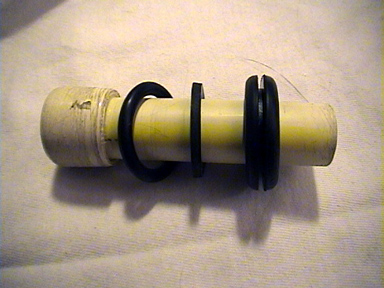
Alternatives to garden hose washer
I used a garden hose washer in this design because i wanted to keep it cheap, and use readily available materials. When I flew the SST-Nozzle, the centering ring would end up on the ground near the launcher. I suspect that the stiff garden hose washer makes an imperfect seal against the interior of the bottle neck, and blow-by sends the centering ring flying. I purchased some alternates, show here. L to R: O-ring, black rubber washer, electrical grommet. Which one works best for you?
Email me with your results, improvements or failures.
This page gets quite a few hits, please email me some feedback on your experience.
indiakarl *at* yahoo....
SST-Nozzle will have it's own domain:
Polyethylene terephthalate when i get the pages transfered... real soon
Notes
The centering ring can probably be improved on.
The CPVC nozzle doesn't have to be as long as the example here. After
burn-out, the SST-Nozzle becomes tail dead weight, which needs to be balanced
out with nose weight to keep your center of gravity above the center of
pressure for stable flight.
The SST-Nozzle can be dismantled inside the rocket body and used on another
rocket. I used a piece of bent coat hanger wire to snag the washer
on the far side and used the centering dowel to push the CPVC part back
through the washer. Then pull the washer out with the coat hanger, and
the CPVC nozzle will fall out the neck of the up-turned rocket